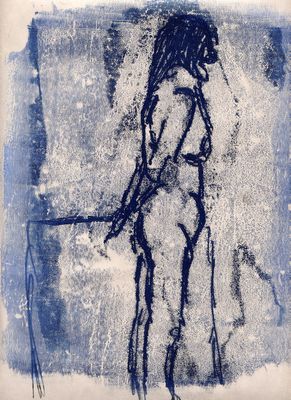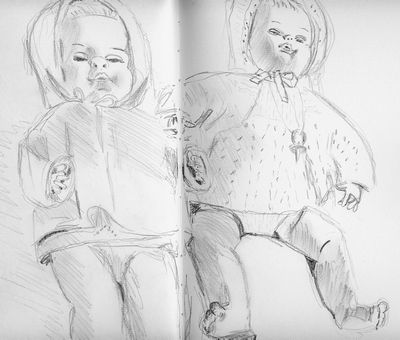
A quick sketch to take advantage of the sunlight streaming in through the window, creating those lovely defining shadows on Tiny and Susan. Drawn in (blunt) graphite stick.

A quick sketch to take advantage of the sunlight streaming in through the window, creating those lovely defining shadows on Tiny and Susan. Drawn in (blunt) graphite stick.
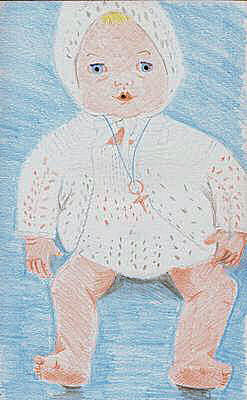
Another doll drawing – in colour pencil. A bit faint for the scanner, unfortunately.
Edit: Mum reminded me that it is possible to autocorrect images with photo software! This is a bit more like the original.
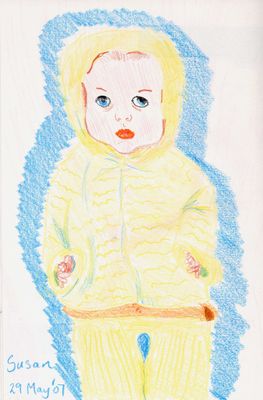 We visited my Gran this weekend. When I went into the room that we were staying in, there were three dolls propped up against the fireplace, carefully wrapped in clear plastic. I recognised them straight away – Tiny, Susan and Mandy. My old dolls. Gran had kept them because she thought someone else might want them some day. Presumably she’s given up on that idea. So I’m taking them back off her hands.
We visited my Gran this weekend. When I went into the room that we were staying in, there were three dolls propped up against the fireplace, carefully wrapped in clear plastic. I recognised them straight away – Tiny, Susan and Mandy. My old dolls. Gran had kept them because she thought someone else might want them some day. Presumably she’s given up on that idea. So I’m taking them back off her hands.
It feels really strange to hold them. The feel of them is so familiar, as is the smell of their hair and the faint clicking noise as they blink their plastic eyelids. With them was a bag full of their clothes, most made by my Mum. They are really lovely. Buried under the clothes was another old doll – one of those Sindy-type stick-thin dolls. I don’t feel as attached to her as I do the other three.
I’ve decided to draw them, and started by using children’s drawing materials – crayon and felt tip. The dolls actually look much nicer than this; the drawings look rather sinister.
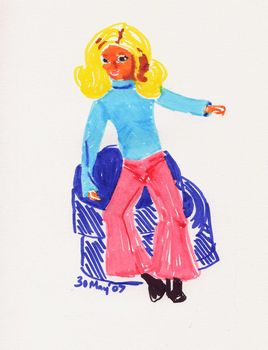
Just some quick oil pastel studies. The trees around here are incredibly resilient. The picture below is of a tree growing on a dark bank alongside a track. It obviously crawled along until it managed to find some light. The picture above is of trees growing out of a stone wall. This is quite a common sight around here.
Spot the difference …
Unfortunately this is a rotten photo, which doesn’t help. I’ve still got more to do on this painting, but will leave it alone now until after the half-term break. It is extremely difficult trying to resolve an abstract painting!
This is taking a lot of my creative energy at the moment. It is my first ‘proper’ canvas (4ft by 3ft). This is a work in progress. I’m not happy with it yet – it needs more ‘life’. Problem is, I’m starting to get too careful with it, which is not what is needed at all!
Oil on wood.
I’ve been quiet here of late because I’ve been busier than usual with career coaching clients. However, I did find time yesterday to stretch my first canvas. This was my first adventure with a staple gun. Stretching a canvas is surprisingly hard work, and can take the skin off your knuckles. Still, I can paint over the bloodstains. 🙂
I’ve been tagged by Dave to tell seven secrets that most people don’t know about me. Thanks, Dave! This is going to take some thought.
1. I’ve started wearing my partner’s clothes. No, really. He was planning to throw out some perfectly good Levi 501’s, so I tried them on. Rather embarassingly, they fit (he is tall and lean, that’s my excuse). It’s just the 34 inch leg length that gives me a few problems.
2. I used to be in a pop group. Well, a pop duo. We both played keyboards, sang, and wrote and arranged our own songs. We had a big gig once at a local pub. The locals even clapped. And we got an article in the local paper (the Sleaford Standard I think it was). We called ourselves Tango, and the headline was ‘Pop duo thirsty for pop success’. Inspired journalism! (Tango was, and probably still is for all I know, a brand of fizzy drink.)
3. I have my hair cut about once every 18 months. It’s getting rather long.
4. I collect margarine tubs – and other plastic pots that Rick would rather I put in the rubbish. It’s a habit I’ve tried to give up in the past, and when we’ve moved house before, a large stack of them from the shed went to the tip. But they can be so useful! And whenever you need one, you can never find one …
5. I used to play the violin. Fortunately for everyone involved, I gave up.
6. I actually like cabbage water. And sometimes I crave spinach. I’m a great believer that my body tells me what it needs. Including Green and Blacks.
7. I usually go to bed at 9.30pm. If I’m still up after that, I start to become incoherent and very grumpy. Must be my age.
Phew. That wasn’t so bad.
I tag:-
Ronell at AfricanTapestry. Ronell does some beautifully loose and energetic watercolours and oil paintings, and accompanies them with a fascinating commentary.
Ryan at Bone and Shadow. Ryan works in pencil and does the most incredibly sensitive drawings of all things to do with bones.
Demiurge – for a wonderful variety of crafts and all things creative.
Bit by Bit – for some stunning colour pencil illustrative work.
Mithi’s Journey – a record of Mithi’s journey from Foundation class to Illustrator, with some very interesting visual work.
Karen’s Creative Journey – daily paintings, mostly watercolor, all beautiful and with some very useful and generous commentary on how she’s tackled the paintings. I learn from her all the time.
Martha’s Trumpetvine – some lovely loose watercolour sketches – a style I aspire to and never reach!
Apologies if you’ve already been tagged. 🙂
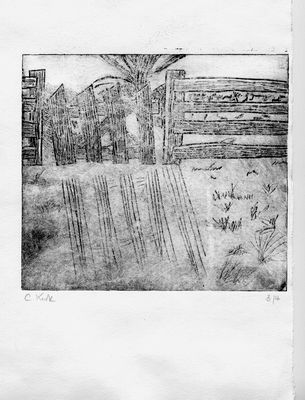
For this print, taken from one of my earlier sketches, I used a piece of intaglio printing card (it has a sort of shiny, plastic surface). Using the edge of a glue spatula (which was all I had to hand, but wasn’t an ideal tool) I carved the design into the card. I then scraped a thin layer of oil based intaglio printing ink across the whole plate and then blotted most of it off again with rags and torn pages from a yellow pages, leaving ink in the grooves and some ink on the surface of the card. The method of printing is the same as for collagraph i.e. soak a piece of heavyweight paper and then blot the excess water off it. Place a registration sheet on a piece of protective newspaper on the printing press. (The registration sheet is a template of the same size as the paper you will print on that marks out where you need to put the plate to ensure prints are positioned correctly. Sadly I didn’t use one for this as I was just testing the plate.) Lay the plate face up onto the registration sheet, place the damp paper over, lining up edges with the registration sheet, cover with newspaper and then the blankets and run through the press. Voila!
I learned that:
a) you need to leave quite a lot of ink on, and be careful not to rub it back out of the design; and
b) it is good to use a variety of cutting tools so that you get a variety of lines.
Monoprinting involves rolling out a thin layer of ink onto a plate (plastic or glass), and then either
a) drawing into the ink, then placing the paper over and rubbing to transfer the image; or
b) placing the paper gently over the inked surface, then drawing on the back of the paper to transfer the ink where you draw the lines.
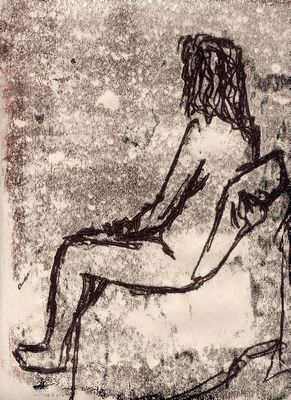
We had to work very quickly, as we were using waterbased ink which was drying fast. Most poses were a maximum of 15 minutes, many were shorter. I took several drawings from each pose, with each drawing taking only 3 minutes or so (that’s fast for me!) I produced about 20 drawings from the one class.
I found that this way of working suited me very well, and I think I need to do something like this more often.
